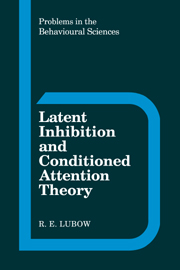Book contents
- Frontmatter
- Contents
- Preface
- 1 Introduction
- 2 Latent inhibition testing procedures
- 3 Variables affecting latent inhibition
- 4 Organismic variables affecting latent inhibition
- 5 Associative learning tests of the effects of stimulus preexposure in children and adults
- 6 Neural substrates of latent inhibition
- 7 Theories and explanations of latent inhibition in animals
- 8 Conditioned attention theory of latent inhibition
- 9 Conditioned attention theory as applied to latent inhibition in humans
- 10 Some applications of conditioned attention theory: learned helplessness and schizophrenia
- Notes
- References
- Author index
- Subject index
2 - Latent inhibition testing procedures
Published online by Cambridge University Press: 13 October 2009
- Frontmatter
- Contents
- Preface
- 1 Introduction
- 2 Latent inhibition testing procedures
- 3 Variables affecting latent inhibition
- 4 Organismic variables affecting latent inhibition
- 5 Associative learning tests of the effects of stimulus preexposure in children and adults
- 6 Neural substrates of latent inhibition
- 7 Theories and explanations of latent inhibition in animals
- 8 Conditioned attention theory of latent inhibition
- 9 Conditioned attention theory as applied to latent inhibition in humans
- 10 Some applications of conditioned attention theory: learned helplessness and schizophrenia
- Notes
- References
- Author index
- Subject index
Summary
Originally, this book was to have been organized such that a separate chapter would be devoted to each of the major paradigms within which latent inhibition had been demonstrated. Although such a categorization proved to be convenient for the initial organizing of the hundreds of published reports, it soon became clear that there was an absence of major differences in the latent inhibition phenomena that could be attributed to the type of testing procedure employed. Therefore, it was decided to present the empirical evidence for latent inhibition on the basis of manipulated variables, organismic variables, and variations across experiments. It is, of course, in this latter category that testing procedures are to be found. Procedures are placed at the head of the list, for two reasons: first, to present evidence that latent inhibition is indeed a ubiquitous phenomenon, found across a very wide range of testing procedures; second, by accomplishing the preceding, to avoid, in subsequent sections, the necessity of repetitiously labeling the experimental procedures for each point that is made.
Before identifying those paradigms in which latent inhibition has been investigated, two general comments are in order, one concerning the number of stages in the procedure, and the second concerning the problem of differentiating the conditioned response (CR) to the target stimulus in the test from the unconditioned response (UR) to that stimulus.
- Type
- Chapter
- Information
- Latent Inhibition and Conditioned Attention Theory , pp. 10 - 57Publisher: Cambridge University PressPrint publication year: 1989



